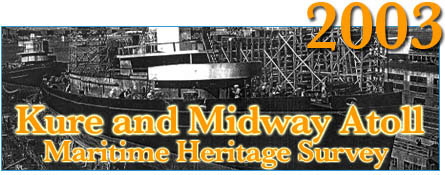
In August and September of 2003, a small team of maritime specialists conducted surveys of several submerged heritage sites at Kure and Midway Atolls. The group conducted successful magnetometer survey, discovered the final resting place of the USS Saginaw, lost at Kure Atoll in 1870, and completed documentation of other historic wreck sites at both atolls, including the American sailing ship Carrollton lost in 1906 and the USS Macaw lost at Midway in 1944.
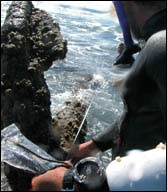 |
| Measuring an exposed anchor on the reef at Midway Atoll. (Photo: Andy Collins, NOAA NWHI CRER) |
|
|
The maritime survey team consisted of Dr. Hans Van Tilburg, Maritime Heritage Coordinator for the Pacific Islands Regional Office(NOAA); Dr. Bradley Rodgers, professor at East Carolina University's Program in Maritime Studies; Andy Lydecker, Panamerican Consultants Inc.; and Kelly Gleason, Ph.D. graduate student at East Carolina University's Program in Coastal Resources Management. The Reserve's research vessel Mana Cat and crewmen Don Moses and Tony Sarabia, provided a lift to and from Kure and functioned as a diving platform.
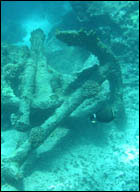 |
| Anchors at the USS Saginaw Site, Kure Atoll. (Photo: THans Van Tilburg, NOAA NMSP) |
|
|
This project featured coordination with a number of partner agencies involved in resource protection in the NWHI. The Maritime Heritage Program team, in order to work in state and federal waters, sought and received permission from: the State Historic Preservation Office; the U.S. Fish and Wildlife Service; and, since two of the four wrecks studied were U.S. Navy vessels, the Naval Historical Center in Washington D.C..
Expedition results feature the discovery of the USS Saginaw at Kure Atoll. The USS Saginaw captures a critical period of American involvement in the Pacific, an historic vessel of the "old steam navy." The side wheel steamer served in the East Indian squadron protecting American citizens in China and Japan and suppressing pirates. In 1862 she joined the Pacific squadron and operated on the West Coast to prevent Confederate activity. Her cruises took her to many ports in Mexico and Central America.
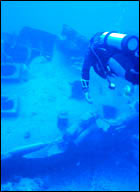 |
| Diver approaching USS Macaw Site, Midway Atoll. (Photo: Andy Collins, NOAA NWHI CRER) |
|
|
The USS Saginaw served as the supply ship for the team of engineers and divers who took up the six-month task of blowing a passage through the reef at Midway when it to be made into a coaling station for the Pacific Mail Steamship Company. At the end of this operation, the acting Captain, Lieutenant Commander Montgomery Sicard ordered that Ocean (Kure) Island, a known navigational hazard, be checked for castaways during the return to Honolulu. The Officer on Deck, Ensign Gorst, was first to hear the breakers and see the surf. Topsails were immediately taken in and both anchors let go, but the ship was bilged in 10 minutes, and within an hour water flooded the engine room and doused the boilers.
The castaways established a camp ashore, and the ship's gig was modified and manned by five volunteers to make the journey east. Ninety three survivors waited on Green Island. Coxswain William Halford was the only one to survive the violent surf landing at Kalihi Kai on Kaua'i after a rough 31 day passage. His Majesty Kamehameha V lent the royal steamer Kilauea to the American minister at Honolulu for the rescue mission, and the remaining crew were picked up on January 3, 1862.
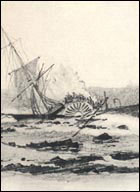 |
| USS Saginaw wrecking on reef at Kure Atoll. (Photo: Read, 1912) |
|
|
During the August 2003 maritime archaeology expedition, the team documented artifacts with digital photography and rough positions of individual items. High surf and rough weather made thorough investigation of the site difficult, and time at Kure Atoll was limited. Initial conclusions are possible following the 2003 discovery, however. The nature of the artifact collection is consistent with that of a wooden hull naval sailing steam ship, battered and broken in the high energy environment of a windward reef setting. Artifacts photographed and recorded by the team include anchors, cannon, sounding lead, a gudgeon and sheathing nails. There are no other similar vessels reported as lost at Kure, and the location of the wreck site coincides with historical reports.
The distribution of artifacts seen so far is consistent with the bow impact and subsequent breaking apart of the vessel. The aft section engineering and boiler components are consequently being strewn further down the reef. This coincides with and supports the account of the shipwrecked crew.
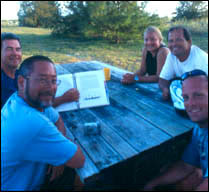 |
| Maritime Heritage Team at Kure Atoll (L to R: Brad Rodgers, Hans Van Tilburg, Kelly Gleason, Tony Sarabia, Andy Lydecker). (Photo: Cynthia Vanderlip, State of Hawaii DLNR ) |
|
|
During the 2003 expedition, the maritime archaeology team revisited an unidentified whaling shipwreck site first discovered by archaeologists in 2002. In 2003, the team expanded the site by finding artifacts to the northwest of the initial area. Inside the calm waters of the lagoon, an extensive scatter of windlass machinery, fasteners, anchors and anchor chain, rigging, hull sheathing and bricks were documented. The distribution and style of these elements indicate the wreck of a large wooden hull sailing vessel of substantial size, most likely the bow section of a mid-19th century whaling vessel. The American ship Parker was lost at Kure Atoll in an area that corresponds to where the wreck was discovered in Kure Atoll lagoon in 2002.
At Midway Atoll, two sites were documented by the maritime archaeology team. The bark Carrollton, under the command of Captain Hinrichs, wrecked on the reef on the southern side of Sand Island, Midway, with no loss of life in December of 1906 en route from Newcastle NSW to Honolulu loaded with coal. The team discovered elements of the Carrollton spread over an area of almost 1,000 feet in length, both inside and outside the reef crest to the south of Sand Island at Midway Atoll. Data collected in the field contributed to the creation of a site plan of the Carrollton shipwreck.
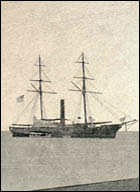 |
| USS Saginaw. (Photo: Read, 1912) |
|
|
The shipwreck USS Macaw was also documented by the team of maritime archaeologists in August of 2003. Following her launching and shakedown cruise, Chanticleer-class USS Macaw ASR-11 sailed to Espiritu Santo, Wallis Island, and Funafuti where she was involved in hydrographic survey. Recalled to Pearl Harbor, Macaw as immediately sent to Midway Atoll on her first salvage mission.
The Macaw was initially stranded on the reef at Midway on January 16, 1944 during the attempted rescue of the submarine USS Flier. Due to the pressing need to maintain an open channel, salvage attempts on the Macaw began as soon as possible. Three separate attempts were made to refloat the USS Macaw, without success. During heavy weather on the night of February 12-13, the ship broached and gradually slipped into deeper water. Complete salvage of the USS Macaw was then considered improbable, and efforts focused on removing equipment and clearing the channel. Finally, the decision was reached to set charges on the remaining superstructure and level the Macaw in place. It took more than six months to clear the channel of the ex-USS Macaw. The wreck was eventually flattened and the evidence of months of hard work, thousands of pounds of explosives and hundreds of dive-hours by the salvage crew is plain.
The documentation of these wreck sites at Midway Atoll and the discovery of the USS Saginaw at Kure Atoll represented an important step towards the MHP's goal of inventory and documentation of the maritime heritage sites in the Northwestern Hawaiian Islands.
Wreck sites in these remote locations, like the precious natural resources, are untouched and pristine. Both heritage and natural resources in the NWHI deserve our best efforts at preservation and conservation.

Additional Resources and Links
National Marine Sanctuary Pacific Islands Region
Northwestern Hawaiian Islands Coral Reef Ecosystem Reserve
Northwestern Hawaiian Islands Multi-Agency Education Project
|





